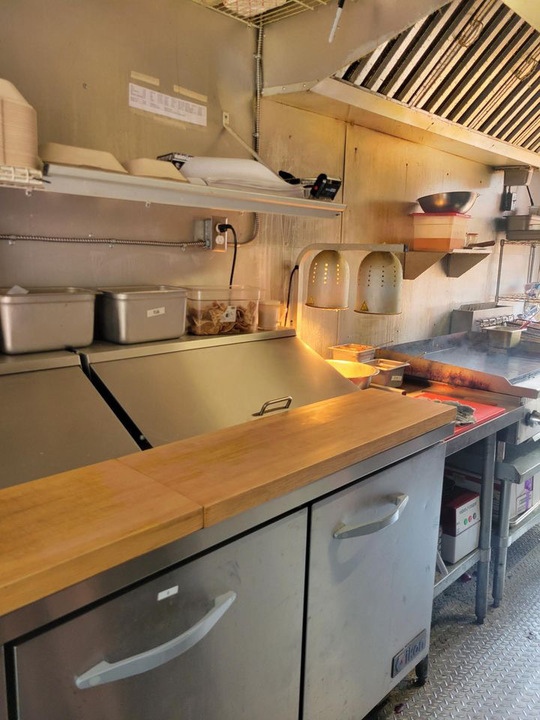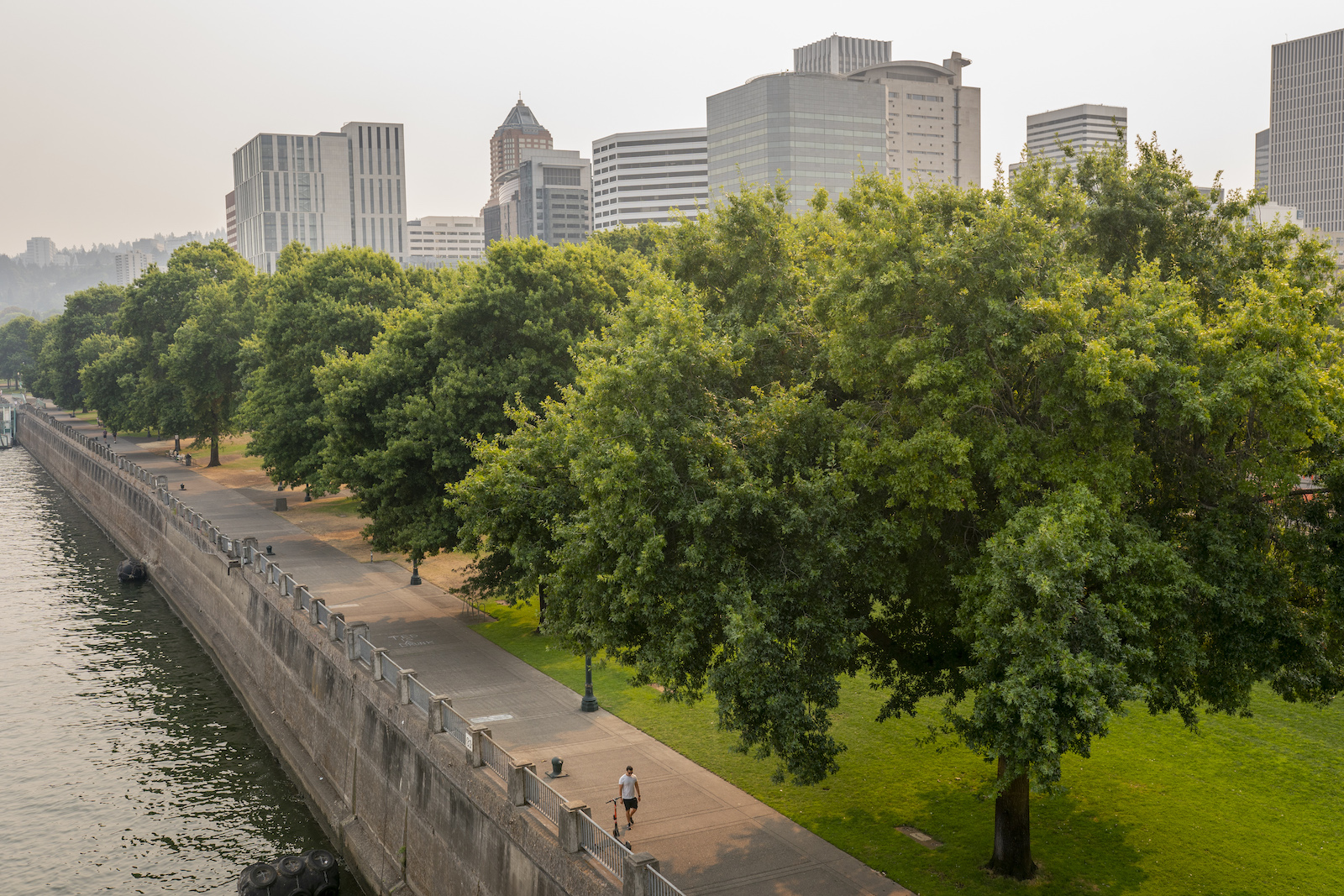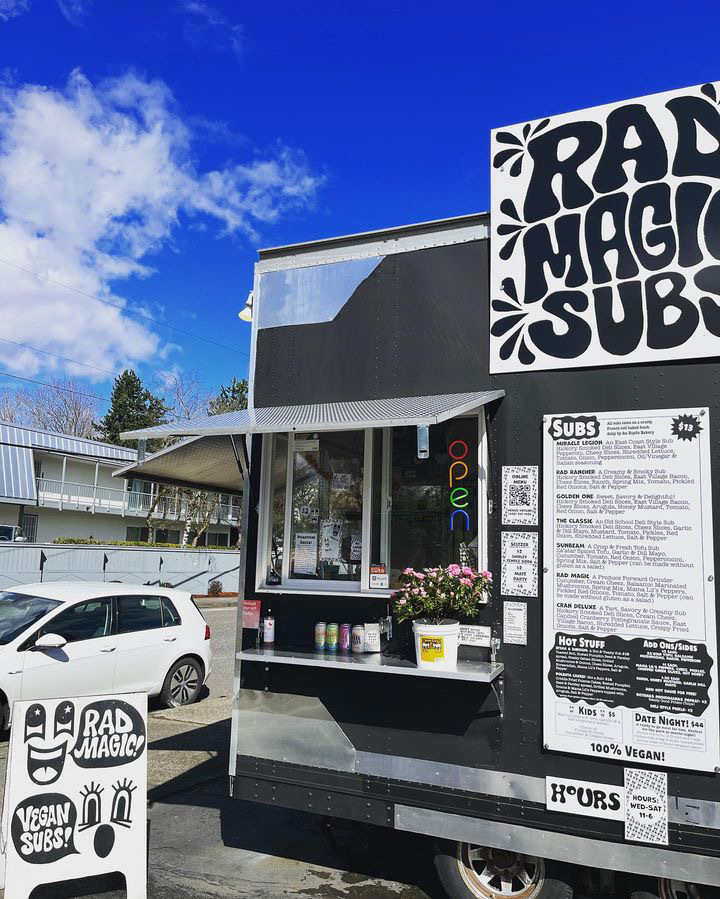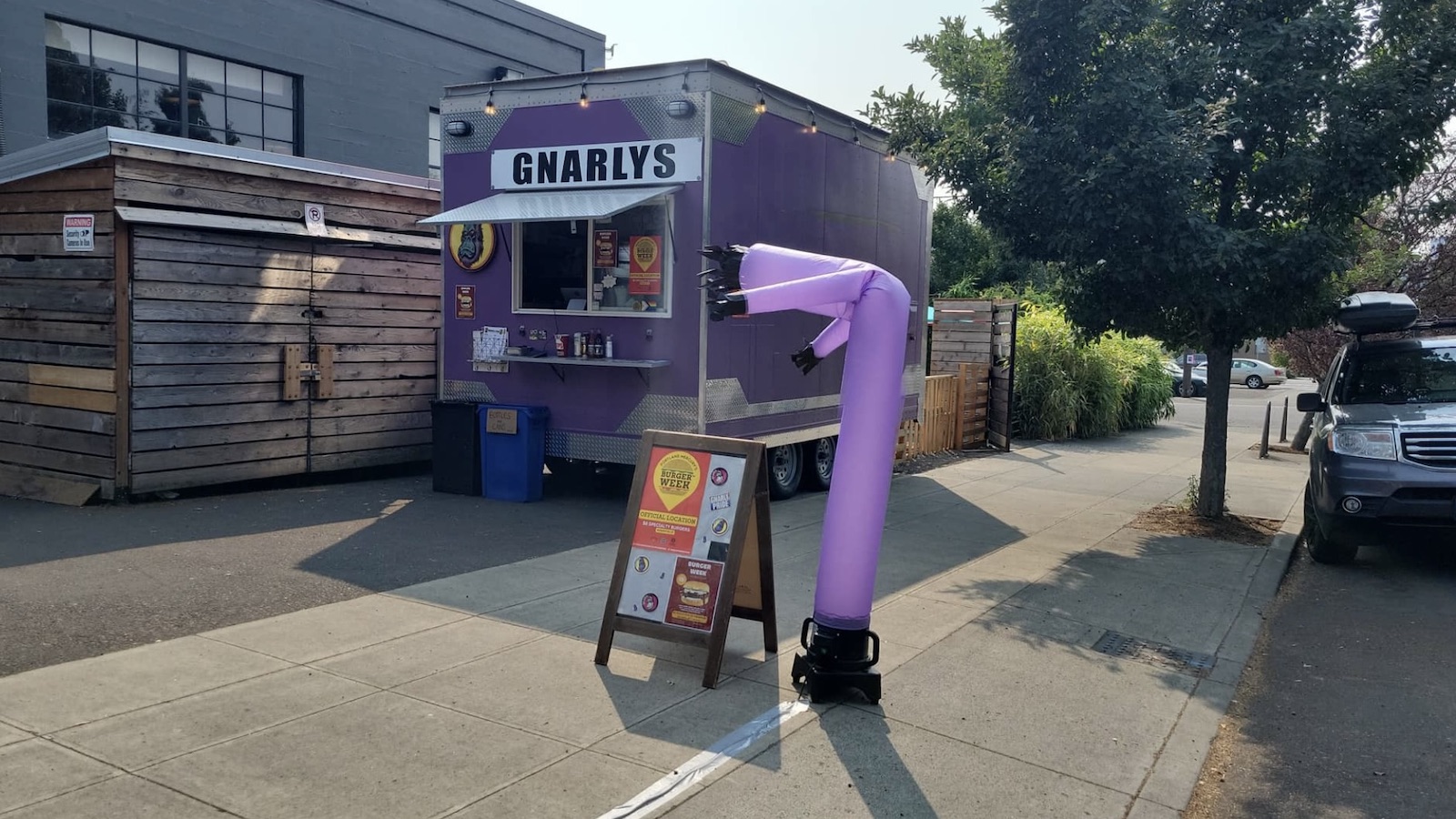This story is part of Record High, a Grist series examining extreme heat and its impact on how — and where — we live.
When Chris Hudson saw a heat advisory in the forecast for the Portland, Oregon, area earlier this month, he sprang into action. Things were about to get sweaty in his vegan food truck, and turning on its 75-pound deep fryer and 500-degree-Fahrenheit grill seemed like a bad idea.
“We are hoping to make it through the next few days by offering a cold menu,” he told his business’s followers on Instagram. Instead of grilling his famous meat-free burgers, he would serve a new “chik’n salad sando” and a “BBQ chik’n wrap.” In lieu of fries, chips. Plus, for dessert, several flavors of dairy-free milkshakes and soft-serve ice cream with chocolate dip.
The new menu was meant to tamp down temperatures inside Gnarlys, the popular food truck Hudson opened in 2021. But when the mercury climbs into the upper 90s and beyond — as it did earlier this month, breaking August records for the Portland area — there’s only so much he can do. “We were still at, like, 102 in the cart,” he told Grist, even with a portable AC unit and a fan running around the clock, and with all the windows open.
A food truck is basically “a metal box,” he added. “The sun is beating down on this metal box.”
Hudson is just one of many food truck owners across the U.S. who are struggling to contend with longer and hotter summers. This year alone has seen thousands of daily temperature records fall, and a brutal series of enduring heat waves has made this summer the hottest on record for more than a dozen cities in the South. Among major cities nationwide, heat waves are now happening three times more often than they used to in the 1960s.
The trend is particularly pronounced in Portland, a historically temperate city with more than 1,000 food trucks and carts, one of the highest numbers per capita in the country. All those mobile food businesses are dealing with a spike in the frequency, duration, and intensity of heat waves even more dramatic than what other U.S. cities are facing. Portland used to get about a week’s worth of 90-degree days every year; now it gets 27. Residents spend more than three times as many hours enduring a heat index above 90 degrees, sharply increasing the risk of heat-related illness.
“I didn’t think I would have to worry about heat in Portland,” said Hudson, who moved to the city from Chico, California in 2019. He had ruled out his second-choice city — Austin, Texas — because of its high temperatures. But now in Portland, he said, “we’re dealing with 100-something days every year … I’m worried to the point where I don’t really want to continue to be in a food truck next summer.”

Portland’s most recent heat wave reached its peak in the afternoon of Monday, August 14. Around 4 p.m. that day, the thermometer at the Portland International Airport read 108 degrees Fahrenheit, the second-hottest temperature ever recorded in the city.
But that was just the beginning for the city’s food trucks. Hours before then, as early as 9 in the morning, the temperature inside Rad Magic Subs had already hit 108 degrees. Justin Miller, who opened the submarine sandwich food truck two and a half years ago, didn’t stick around to see how hot things would eventually get — he announced a temporary closure on Instagram. But he knew from experience that the mercury would only climb higher inside the truck, potentially all the way up to 115 or 120 degrees, as the day went on. The owner of another food truck that did open for business that day reported a peak temperature of 122 degrees.
This is typical. Most food trucks are retrofitted from cargo vehicles like moving vans, and are inherently prone to high heat. They have metal exteriors, limited air flow, and lots of heat-generating kitchen equipment crammed into a relatively small space — sometimes as small as 70 square feet. The exact setup varies from truck to truck, depending on the kind of food being sold, but might include a massive flattop griddle next to a deep fryer, or perhaps an industrial-sized oven — in addition to a big fridge, which lets off heat in order to keep food cold. Other features of a typical food truck include a large ventilation system above the cooking equipment, a generator to keep the fridge and freezer running, tanks for wastewater and freshwater, and separate sinks for washing hands and doing dishes.
Unless clouds roll in to block the sun, “you really can’t get it much cooler in the cart,” said Miller. Small fans and AC units are often ineffective, since the air they blow tends to get sucked up into trucks’ exhaust fans. Even on a 61-degree evening, researchers have shown that temperatures near a food truck’s cooking area can reach as high as 105 degrees. In some jurisdictions like Los Angeles, although not in Portland, health-code regulations make it harder to cool off by preventing food trucks from opening their back doors, in order to keep insects away from the food.
Miller joined many Portland-area food truck owners in deciding to close down during the heat wave, rather than suffer through. But that’s not a decision to be taken lightly, in a sector marked by financial precarity. Many food truck owners will go to great lengths to stay open, even under sweltering, 100-degree-plus conditions.
“We have such a small profit margin that every single day matters,” said Kiaha Kurek, who owns a Hawaiian food truck in Portland called Hapa Howies, which serves a variety of hot lunch plates. Like many of the food truck owners Grist spoke with, she said she doesn’t let her two employees work once outdoor temperatures start to feel “unbearable.” But she’s willing to put herself through those uncomfortable conditions.

If it’s been a slow couple of weeks, Kurek will brave the heat by herself, wrapping a wet towel around her neck as she prepares a limited menu of cold poke bowls. “You have to think strategically,” she said. “Make sure you have lots of water on you, wear tank tops, wear shorts.”
Other strategies to beat the heat include everything from running cool water over one’s hands to eating smaller meals and nibbling spicy foods to induce sweating. One crepe truck owner in Durham, North Carolina, told the News & Observer they close their eyes and pretend the intense heat is “from the sun’s rays as we lie on a pristine beach somewhere in Aruba.” Another said they sing Christmas carols, perhaps to conjure the cooling image of snow.
Leah Tucker, founder and executive director of the Oregon Mobile Food Association, a membership organization that represents the state’s food trucks and carts, said these kinds of coping mechanisms are typical: Most food trucks are owner-operated, and those owners often put their health and safety in the backseat so they can prioritize the well-being of their business. Tucker said she spends hot days encouraging food truck owner-operators to limit their hours or shut down temporarily.
“Taking a day off and closing on a really hot day is not the worst thing that could happen,” she said. “A worse scenario would be working a full shift in an extremely hot environment — and then having to take more time off because you’ve had a heat stroke.”
Indeed, the consequences of heat exposure can be crippling. Every year, extreme heat kills more Americans than any other kind of weather-related disaster, and even among food truck veterans who say they’re “used to” the heat, researchers out of the University of California, Los Angeles Heat Lab have documented many cases of heat-related exhaustion, vomiting, heart attacks, nausea, and more. Workers of color may be particularly vulnerable to the heat, due to centuries of baseless assumptions that these demographics are less affected by high temperatures. Sofia Sabra, a researcher at the Heat Lab, said she’s interviewed food truck workers who thought they were able to take longer shifts with no breaks “because they were Mexican.”
Despite the human health risks, many of the food truck owners Grist spoke with expressed a greater concern over equipment malfunctions during a heat wave — especially faulty refrigerators, which may not function well in temperatures above 90 degrees. Buddy Richter, who owns a Portland food truck called Buddy’s Steaks, said he stuffs ice into his fridge to keep the internal temperature from exceeding 40 degrees and spoiling his house-made vegan meats and cheeses. If the fridge breaks altogether, he said, that can lead to thousands of dollars in lost food and repair costs.

As with Hudson’s chik’n sandos and Kurek’s poke bowls, Richter often prefers to offer a special “heat wave menu” rather than close down temporarily. Still, this strategy can cause further complications. When Richter offers a hot-weather special caprese sandwich instead of his normal plant-based cheesesteaks, some visitors grumble about the change. Some are reluctant to spend money on simpler menu items that they think they could prepare at home, for cheaper.
“Half the people show up and walk away,” he said. Sometimes, he barely manages to break even on these limited-run menus, since it costs extra to buy new ingredients and equipment. Miller, with Rad Magic Subs, experiences something similar — ”People say they can make [cold] sandwiches already” — while Kurek said she’ll get customers who say, “What do you mean, you don’t have your deep fryer on? It’s not that hot.”
“I look at them, and I’m like, are you crazy? It’s 104 degrees outside, how hot do you think it is in here?” she said. “There’s an absolute lack of understanding.”
Gnarlys, which not only changed its menu during the heat wave but also shifted its operating hours, took to Instagram with a request for customers to “be patient and understanding” in the face of heat-related service changes. “Being frustrated and taking it out on us is not helpful for anyone. Contrary to popular belief, we do not control the weather.”
As climate change progresses, summers are only expected to get hotter. Already, the number of Americans exposed to dangerous heat waves every year has jumped by more than 125 million since 2000. And in the Pacific Northwest, by 2050, heat waves as extreme as the one that killed more than 250 people in the region in 2021 are expected to occur once every six years — rather than once a millennium.
These forecasts only increase the feeling of precarity that defines daily life for many food truck owners. Combined with the increasing risk of wildfires and the suffocating smoke they bring, Miller, with Rad Magic Subs, said the weather is “like an unfightable foe.”
“It’s our biggest challenge for sure,” he told Grist, even bigger than “the economy, supply issues, anything.” With each summer forcing more and more multi-day closures, he added, “the business model of a food truck seems to be less viable year after year.”
Many of the food truck owners Grist spoke with have the long-term goal of opening a traditional brick-and-mortar restaurant; the food truck is just a stepping stone along that path. But with so few options to mitigate the relentless and worsening heat, people like Hudson and Kurek have been eager to accelerate that transition. Kurek already has a September opening date for her restaurant — a joint venture with a Portland pop-up restaurant and a new brewery. (The Hapa Howies food truck will stay in operation.)
Hudson, the owner of Gnarlys, said he isn’t yet financially ready for that move. “But I’m ready when it comes to my mental state,” he said. He’s already planned out a new, expanded menu for when that day finally comes.



